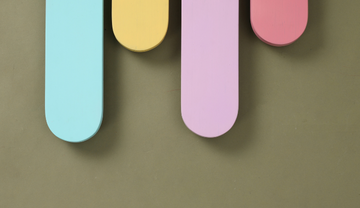If you have noticed children walking along on the footpath or in the park they are naturally drawn to the curb, they try to balance on it and walk. This is because young children are working on developing equilibrium.
Between the time they are born to the time they are about 2 years and well into toddlerhood, young children develop many movements – the most important one perhaps is walking independently. But they aren’t yet walking like adults and still need to gain stability.
The balance beam is an ideal tool to help children work on their sense of balance and development of equilibrium in a fun and playful manner.
Here are a few reasons why the balance beam is great addition to your child’s play space especially in these times when stepping out isn’t an option for many.
-
Aids Proprioception
In simple terms, proprioception is our perception of our own body and how it moves in space. This sense is essential for us to stand upright, walk and move around doing everyday things. Using the balance beam, offers the child a safe way to work on this sense.

-
Coordination
Coordination is ability to use different parts of your body in harmony and efficiently for the intended purpose. Coordination is needed for everyday functioning as well as to participate in sport and play activities. The balance beam helps the child build coordination at their own pace and space.
-
Balance
Balance is the ability to control the position of your body both whiles being stationary and while moving. Just like coordination, developing a sense balance is a pre-requisite for carrying out activities of everyday living like walking, sitting, standing, dressing up etc.
You child can use the balance beam to develop a sense of balance in a fun and playful manner.
-
Social play
Play is the work of the child and as babies become toddlers, social play becomes more significant. When children play together, they learn teamwork and social skills. On the balance beam, children can take turns and play together.

-
Build focus and concentration
Children tend to focus on activities that they find fun and enjoyable. Walking on the balance beam requires your child to focus and concentrate on the task. Building concentration helps in both academic and non-academic pursuits by reducing distraction and helping in problem-solving.
-
Postural control
Having good posture is essential to the optimal development of the different muscle and bone groups of the body, improving blood flow and maintaining a healthy nervous system. If children develop good postural control early in life by using the balance beam, it lays a strong and healthy foundation for the rest of their lives.
-
Strengthens the core
When children use the balance beam, their core muscles are activated and strengthened without even them realising it. A strong core is the base of a healthy body.
-
Improve visual perception
When children walk on the beam, they need to focus on what is in front of them but also keep their peripheral vision in check thereby improving visual perception. Strong visual perception skills are essential for fine-motor development and other skills like reading and writing.
While walking one a straight line or on a beam seems simple to most adults, it requires children to use a lot of effort and many muscle groups together to achieve this. Apart from aiding to develop equilibrium and balance, it also helps to develop better proprioception and visual perception skills which are all essential for everyday function. Walking on the balance beam also strengthens the core, develops good posture and aids in coordination laying a strong foundation upon which children can build their future.
Some Game ideas for the Beam :
Here are some fun games to try with your toddler or older child on the balance beam. You can play these games once they are comfortable walking on the beam – to increase challenge and keep it interesting.
- You can ask you child to walk on the beam in different ways – sidestep, backwards, tip toes and even try different animal walks on the beam.
- Your child can start out by balancing their toys on the beam and then they can walk on the beam themselves and either pick up each toy or walk over them.
- Use a timer to see how fast your child can go from one end of the beam to the other and back -without getting off it even once.
- Play the traditional lemon and spoon on the balance beam.
- Ask your child to stand with their hands stretched out and balance a book/ toy /sandbags and walk on the beam
- Ask your child to hold a bell and walk on the beam making sure not to ring the bell even once.
- Balance a pillow on their head and walk on the beam.
- Walk on the beam holding a glass of water and try not to spill any of it.
- Put on some music and walk on the beam – your child must stop when the music stops.
- Most games like stacking and matching can be made fun by including the balance beam – for stacking, place the rings on one end and the dowel on the other, ask your child to walk across the beam and stack – bringing only one ring at a team. This can be done for matching games, puzzles and adapted to other games as well.






